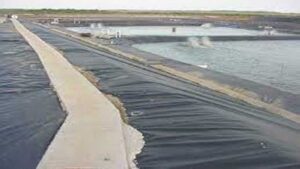HDPE Geomembranes: A Cost-Effective Solution for Landfill Construction
As the global population continues to grow and urbanization accelerates, waste management has become an increasingly critical challenge. Landfills, despite efforts to reduce waste, remain a necessary component of waste management strategies worldwide. High-Density Polyethylene (HDPE) geomembranes have emerged as a cost-effective and efficient solution for modern landfill construction. This blog post explores how HDPE geomembranes are revolutionizing landfill design and operation, with a particular focus on applications in the United Arab Emirates (UAE) and the HDPE Geomembrane UAE market.
The Landfill Challenge
Landfills pose significant environmental risks if not properly constructed and managed. These risks include:
- Groundwater contamination from leachate
- Soil pollution
- Greenhouse gas emissions
- Odor and vector (e.g., rats, birds) problems
Traditional landfill construction methods often struggle to address these issues effectively and economically. This is where HDPE geomembranes come into play.
HDPE Geomembranes: The Game-Changer
HDPE geomembranes sheet offer a range of properties that make them ideal for landfill applications:
- Impermeability: Excellent barrier against liquids and gases
- Chemical Resistance: Withstands a wide range of chemicals found in waste
- UV Stability: Resists degradation from sunlight exposure
- Flexibility: Conforms to ground settlement and movements
- Durability: Long service life, often exceeding 100 years
- Cost-Effectiveness: Lower installation and maintenance costs compared to alternative solutions
Let’s explore how HDPE geomembranes contribute to cost-effective landfill construction:
- Enhanced Leachate Management
Leachate, the liquid that passes through waste, is a primary concern in landfill management. HDPE geomembranes provide an impermeable barrier that prevents leachate from contaminating soil and groundwater.
Cost Benefits:
- Reduced environmental remediation costs
- Lower long-term monitoring expenses
- Decreased risk of regulatory fines and legal liabilities
HDPE Geomembrane UAE Application: In the arid climate of the UAE, where groundwater resources are scarce and precious, the use of HDPE geomembranes in landfills has become standard practice, significantly reducing the risk of groundwater contamination.
- Improved Gas Collection
Landfill gases, primarily methane and carbon dioxide, contribute to greenhouse gas emissions. HDPE geomembranes help in efficient gas collection systems.
Cost Benefits:
- Potential revenue from captured methane as an energy source
- Reduced carbon footprint and associated carbon credits
- Lower odor control expenses
UAE Perspective: The UAE’s commitment to reducing its carbon footprint has led to increased focus on landfill gas management, with HDPE geomembranes playing a crucial role in these efforts.
- Increased Landfill Capacity
The strength and flexibility of HDPE geomembranes allow for steeper side slopes in landfill design, increasing overall capacity without expanding the footprint.
Cost Benefits:
- More waste storage in the same land area
- Extended landfill lifespan
- Reduced land acquisition costs for new landfills
HDPE Geomembrane UAE Impact: In the UAE, where available land for waste management is limited, the use of HDPE geomembranes has allowed for more efficient use of existing landfill sites.
- Simplified Construction Process
HDPE geomembranes are relatively easy to install compared to traditional clay liners or concrete systems.
Cost Benefits:
- Faster construction times
- Lower labor costs
- Reduced equipment requirements
UAE Construction Advantages: The ease of installation is particularly beneficial in the UAE’s harsh climate, allowing for quicker project completion and reduced exposure of workers to extreme temperatures.
- Reduced Maintenance Requirements
The durability and chemical resistance of HDPE geomembranes result in lower maintenance needs over the landfill’s lifetime.
Cost Benefits:
- Decreased repair and replacement expenses
- Lower operational costs
- Extended service life of the landfill
HDPE Geomembrane UAE Durability: In the UAE’s extreme climate, the durability of HDPE geomembranes translates to significant long-term cost savings in landfill maintenance.
- Enhanced Environmental Compliance
HDPE geomembranes help landfills meet stringent environmental regulations more easily and consistently.
Cost Benefits:
- Reduced risk of regulatory fines
- Lower costs for environmental monitoring
- Improved public perception and reduced community opposition
UAE Regulatory Context: As the UAE continues to strengthen its environmental regulations, HDPE geomembranes provide a reliable solution for ensuring landfill compliance with minimal ongoing costs.
- Versatility in Closure and Post-Closure Care
HDPE geomembranes are effective not only during the active life of a landfill but also in closure and post-closure care.
Cost Benefits:
- Simplified closure process
- Reduced post-closure monitoring costs
- Potential for earlier release from post-closure care obligations
UAE Long-Term Management: The long-term performance of HDPE geomembranes aligns well with the UAE’s focus on sustainable waste management and land reclamation efforts.
Challenges and Considerations
While HDPE geomembranes offer significant cost benefits, there are some challenges to consider:
- Initial Investment: The upfront cost of HDPE geomembranes can be higher than traditional materials, though long-term savings often justify this investment.
- Installation Expertise: Proper installation is crucial for optimal performance, requiring skilled professionals familiar with local conditions.
- Quality Control: Rigorous quality control measures are necessary during manufacturing and installation to ensure long-term effectiveness.
- End-of-Life Management: While HDPE geomembranes have a long lifespan, eventual replacement and disposal must be factored into long-term planning.
Future Outlook
The role of HDPE geomembranes in landfill construction is set to grow, driven by several factors:
- Technological Advancements: Ongoing research is improving the performance and sustainability of HDPE geomembranes.
- Stricter Regulations: As environmental regulations become more stringent globally, the demand for effective containment solutions like HDPE geomembranes will increase.
- Sustainable Waste Management: The push towards more sustainable waste management practices aligns well with the benefits offered by HDPE geomembranes.
- Smart Landfills: Integration of HDPE geomembranes with sensors and IoT technologies promises enhanced monitoring and management capabilities.
Conclusion
HDPE geomembranes have proven to be a cost-effective solution for modern landfill construction, offering a range of economic and environmental benefits. From improved leachate and gas management to increased capacity and simplified construction, these materials are transforming how we approach waste containment.
The HDPE Geomembrane UAE market exemplifies how these materials can be effectively deployed in challenging environmental conditions, providing both immediate and long-term cost savings while ensuring environmental protection. As we continue to grapple with the challenges of waste management in an increasingly urbanized world, HDPE geomembranes stand out as a crucial technology in creating more sustainable, efficient, and economically viable landfill solutions.
By embracing HDPE geomembranes in landfill construction, we not only address current waste management needs but also invest in a more sustainable future, balancing economic considerations with environmental responsibility.


